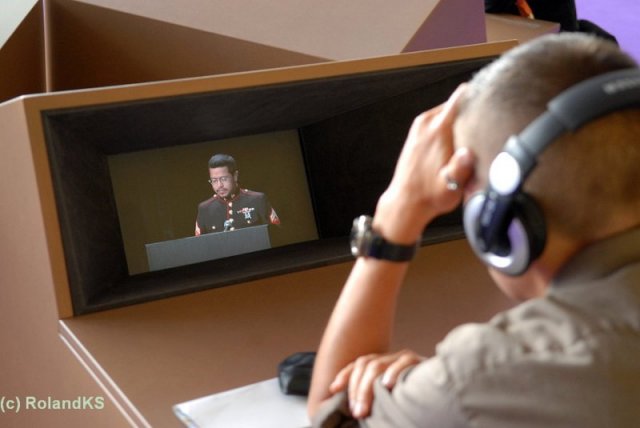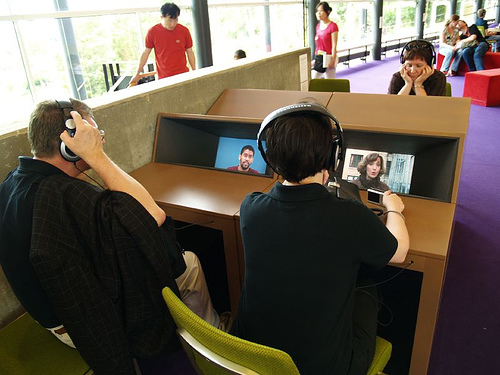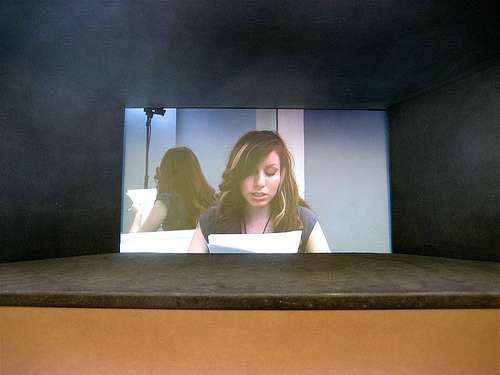Flipping the Script
As western audiences increasingly switch off from generic reporting of the wars in Iraq and Afghanistan, Imogen O'Rorke finds the news-unworthy testimonies at Tate Modern a much needed corrective
It's been seven years since George Bush dubiously declared ‘War on Terror'. Since then, there have been an estimated 95 thousand civilian deaths (655 thousand by some accounts), 4,730 US military deaths, 288 British deaths and the toll still rises. In July, a Pentagon-commissioned study by Rand Corp admitted that the Bush administration strategy to defeat Al-Qaeda had been ‘unsuccessful' and condemned the most unpopular foreign war since Vietnam as badly ‘off target'. Psychologically, the conflict has taken a heavy toll on the American people and contributed to a super sized dose of soul-searching, as evidenced by Hollywood's recent output. When even the caped crusader, Batman, is forced to admit defeat against conductor of chaos, the Joker, it has been a dark night indeed.
David Thorne et al, Script: Citizen: 248 predictions about what I will do when democracy comes, 2008
So how has the art world responded to this legacy of disasters? Apart from the ICA's Memorial to The War in Iraq commission last year, why haven't we seen any major exhibitions tackle the subject? 9 Scripts from a Nation at War at Tate Modern's Level 2 Gallery (a modest space reserved for media art) attempts to do just that, by exploring the psychology of a nation in conflict. Transcripts, testimonies, interviews, notations and web logs form the ‘scripts' for this quietly controversial ten-part video installation which interrogates contemporary warfare and citizenship through semantics and academic participatory games.
According to the script accompanying the Scripts, the curators Amy Dickson and Rachel Taylor and artists David Thorne, Ashley Hunt, Sharon Hayes, Andrea Geyer and Katya Sander set out to ‘examine the ways in which war determines scripts and certain roles such as "citizen", "veteran", "detainee", "correspondent"' and to investigate how written and spoken language affects identity and is fundamental to defining and perpetuating the structures of power. The exhibition is the last in a series of four which set out to ‘explore citizenship through themes of economy, belief, the state and the individual'. All very worthy and public-spirited, it would appear, but this time, at least, the art transcends the blurb.
Not everyone who wanders into this show will recognise the trendy, postmodern techniques employed, such as re-enactment, but most will be familiar with the ubiquitous ‘workshop' approach. In fact, at times it's a bit like watching role play exercises at a group therapy or adult education session, but that's not necessarily a criticism. These experiential techniques generate a healthy climate of debate and ensure the subject matter never gets didactic.
The show opener, Script: Citizen: 248 predictions about what I will do when democracy comes, is the most accessible, but also the weakest. Statements like ‘I will be a hotbed of insurgency' and ‘I will ignore the dim whispers of the missing' are chalked up on a blackboard by a group of performers and then immediately erased. The phrases are frustratingly flippant and oblique, but that's most likely the point. As viewers, aka ‘Citizens', this is an upfront challenge to reappraise our feelings about the conflicts and reactions to them.
In the main room, we are presented with a choice of listening booths. Dominating the show, in both size and content, is the triptych: Script: Detainee: Please tell me when it's my turn to speak because I don't know what's going on here. This is a documentation of a five hour public reading of the Combatant Status Review Tribunals, which were conducted at Guantanamo Bay in 2004/5. There are 558 tribunal transcripts like this, each around 100 pages long, invisible to the public on account of the sheer volume of paperwork.
9 Scripts from a Nation at War, gallery view
In the tradition of reenactment art (a form popularised by Rod Dickinson with The Milgram Experiment and Jeremy Deller's Turner Prize-winning The Battle of Orgreave, where events of historical significance are restaged) the subject matter is suitably cryptic. The reconstruction of tribunals enables the participants (both the actors and the audience) to experience the conditions under which the terror suspects were condemned and to witness the injustice (i.e, the inbuilt inflexibility) of the Guantanamo tribunal procedure, where detainees were expected to represent themselves without foreknowledge of the evidence against them or being able to speak directly to witnesses. In the words of detainee, Ashraf Salim, a former schoolteacher:
I know my fate is predetermined by this tribunal. This tribunal is not real. My presence, one defending myself, or not defending myself is of no importance whatsoever...where is the justice here?
Does the fact that they are spoken by a middle-class, white woman make them more or less chilling to an art loving audience? Tate goers were invited to find out for themselves at a live reading which accompanied the exhibition.
Re-enactment is an appropriately ironic technique to use here, as the term ‘enactment' is used in law to mean decree, edict or dictat and these were extra-legal proceedings. Re-enactment is also a traditional, popular form of learning which dates back to the pageant and the medieval Passion play. What the artists seem to be saying is that in order to understand recent history, we need to experience it emotionally and unfiltered, not as a minor item in an overcrowded news agenda.
The same technique creates a distancing effect in Script: Veteran: I am thinking I should put on my uniform. Here, two retired soldiers prepare a public speech (from a prerecorded interview where they talked about their experiences in Iraq and their subsequent return to civilian life) and then perform it to an empty auditorium. The re-representation of this highly personal material asks the serviceman to re-evaluate their function in this conflict, while at the same time allowing them to reclaim their experiences.
David Thorne et al, Script: Veteran: I am thinking I should put on my uniform, 2008
Private Mickiela Montoya gives a harrowing account of how she became pregnant while serving in the National Guard, only to be told she was going to Iraq and then treated as 'some sort of criminal' for trying to shirk duty. The stressful experience caused her to miscarry, after which she suffered chronic depression before her deployment in Iraq: one trauma supplanted by another. These are every day stories, not media sensations brought to an audience of millions, but they demonstrate how effectively the military machine erases human identity, dignity and individual experience. In the words of Veteran Corporal Jose Omar Portilla:
the hard fact is you're just a number ... you're not in charge of yourself anymore ... from the moment you wake up to when you eat, sleep or go to the rest room.
In another part of the room, actors perform fragments of texts by the same soldiers and others involved in the war. This dry, staged presentation where the actors attempt to define terms like ‘torture' and ‘enemy combatant', reflect how impossible it is to capture the experience of war in words, and how easily the horror can be concealed in paperwork using prescribed terminology. The Lacanian distinction between Speech and Language underpins much of this work. Language is a formal system of signifiers encoding meaning, whereas the act of speaking gives back identity and autonomy to the speakers. The critic is given a face and a voice.
In Script: Correspondent: But you have to tell it in a way that doesn't lose you your credibility we are reminded that it's not just the foot soldiers, but journalists who were strong-armed by the war machine. Here correspondents offer their views on the difficulty of maintaining neutrality when reporting from the front line. One Al Jazeera correspondent, Abderrahim Foukara, reflects on his discomfort when there was pressure from the US Defense department to call the invasion a ‘liberation' or risk being labeled a radical or friend of terrorism. At no time do the journalists interviewed drop their professional, dispassionate demeanour.
Not all the Scripts are equally successful. The re-presentation of web blogs about Iraq by a quasi-teacher figure or the role play exercises of anthropology students talking about the impact of war in the classroom quickly became boring, perhaps because we've become immune to the endless flow of user-generated sludge which is peddled as ‘self-expression'.

9 Scripts from a Nation at War, gallery view
However, there is a wealth of source material to get lost in here. As the different perspectives piled up – each offering a personal and no less valid version of the war – a horrifyingly holistic picture emerges: that of a nation (the US or the UK) so obsessed with analysis, as events unfold in real time or replay, with self-reflection and navel-gazing that we no longer know how to act. A democratic war is a sit-back spectacle.
The power of 9 Scripts... is that it is confrontational and thought provoking without presenting images of death, destruction, torture and viscera and it manages to avoid political tub-thumping. Similarly, with the ICA's Memorial to the War in Iraq, the most successful memorial commissions in the earlier show were the ones which took a step back from the politics and looked at how the media dealt with the conflict. Work like Snapshots from Baghdad by the Slovakian artist Roman Ondák, for example: a disposable black camera on a white plinth, which was supposedly meant to contain pictures from a war zone which will never be developed, and, perhaps, should remain undeveloped.
By focusing on the Scripts – words and semantics which can justify, condemn or seal an individual or a nation's fate – we are forced to interrogate our roles in this conflict and to reassess the position of the Citizen in relation to the State.
Imogen O'Rorke <imogenmaryororke AT hotmail.com> is an artist, writer and new media consultant living in east London
Info
9 Scripts from a Nation at War, Level 2 Gallery, Tate Modern, 13 June – 25 August 2008
Mute Books Orders
For Mute Books distribution contact Anagram Books
contact@anagrambooks.com
For online purchases visit anagrambooks.com









